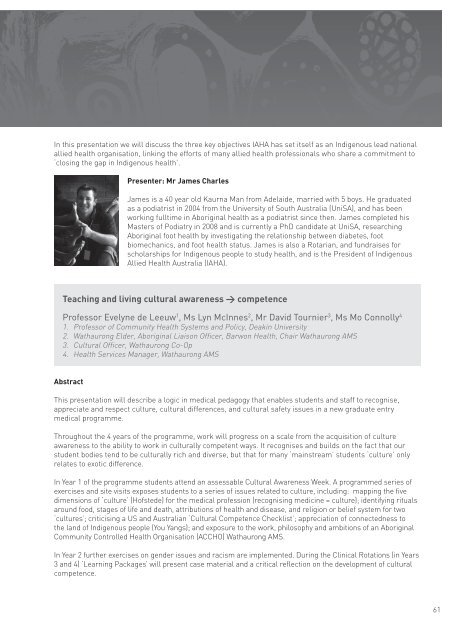abstracts and bios cover_final.indd - LIME Network
abstracts and bios cover_final.indd - LIME Network
abstracts and bios cover_final.indd - LIME Network
Create successful ePaper yourself
Turn your PDF publications into a flip-book with our unique Google optimized e-Paper software.
In this presentation we will discuss the three key objectives IAHA has set itself as an Indigenous lead nationalallied health organisation, linking the efforts of many allied health professionals who share a commitment to‘closing the gap in Indigenous health’.Presenter: Mr James CharlesJames is a 40 year old Kaurna Man from Adelaide, married with 5 boys. He graduatedas a podiatrist in 2004 from the University of South Australia (UniSA), <strong>and</strong> has beenworking fulltime in Aboriginal health as a podiatrist since then. James completed hisMasters of Podiatry in 2008 <strong>and</strong> is currently a PhD c<strong>and</strong>idate at UniSA, researchingAboriginal foot health by investigating the relationship between diabetes, footbiomechanics, <strong>and</strong> foot health status. James is also a Rotarian, <strong>and</strong> fundraises forscholarships for Indigenous people to study health, <strong>and</strong> is the President of IndigenousAllied Health Australia (IAHA).Teaching <strong>and</strong> living cultural awareness > competenceProfessor Evelyne de Leeuw 1 , Ms Lyn McInnes 2 , Mr David Tournier 3 , Ms Mo Connolly 41. Professor of Community Health Systems <strong>and</strong> Policy, Deakin University2. Wathaurong Elder, Aboriginal Liaison Officer, Barwon Health, Chair Wathaurong AMS3. Cultural Officer, Wathaurong Co-Op4. Health Services Manager, Wathaurong AMSAbstractThis presentation will describe a logic in medical pedagogy that enables students <strong>and</strong> staff to recognise,appreciate <strong>and</strong> respect culture, cultural differences, <strong>and</strong> cultural safety issues in a new graduate entrymedical programme.Throughout the 4 years of the programme, work will progress on a scale from the acquisition of cultureawareness to the ability to work in culturally competent ways. It recognises <strong>and</strong> builds on the fact that ourstudent bodies tend to be culturally rich <strong>and</strong> diverse, but that for many ‘mainstream’ students ‘culture’ onlyrelates to exotic difference.In Year 1 of the programme students attend an assessable Cultural Awareness Week. A programmed series ofexercises <strong>and</strong> site visits exposes students to a series of issues related to culture, including: mapping the fivedimensions of ‘culture’ (Hofstede) for the medical profession (recognising medicine = culture); identifying ritualsaround food, stages of life <strong>and</strong> death, attributions of health <strong>and</strong> disease, <strong>and</strong> religion or belief system for two‘cultures’; criticising a US <strong>and</strong> Australian ‘Cultural Competence Checklist’; appreciation of connectedness tothe l<strong>and</strong> of Indigenous people (You Yangs); <strong>and</strong> exposure to the work, philosophy <strong>and</strong> ambitions of an AboriginalCommunity Controlled Health Organisation (ACCHO) Wathaurong AMS.In Year 2 further exercises on gender issues <strong>and</strong> racism are implemented. During the Clinical Rotations (in Years3 <strong>and</strong> 4) ‘Learning Packages’ will present case material <strong>and</strong> a critical reflection on the development of culturalcompetence.61
















